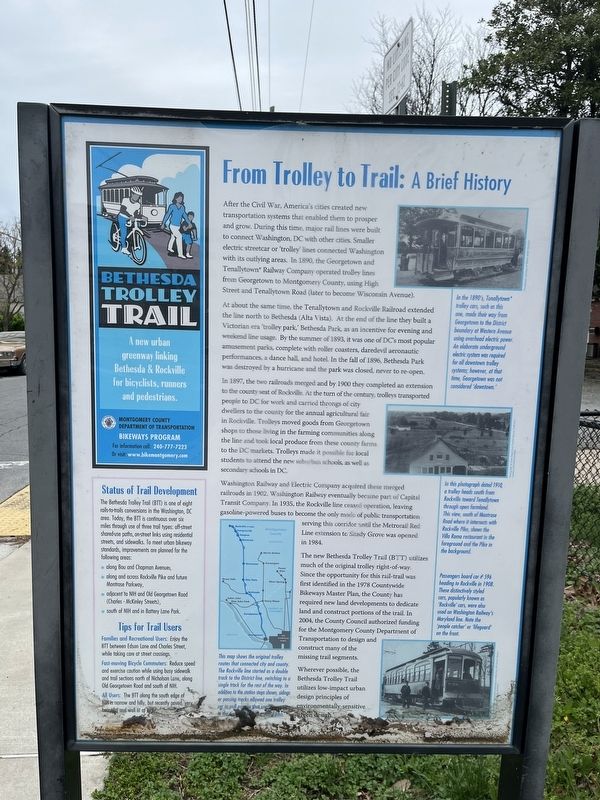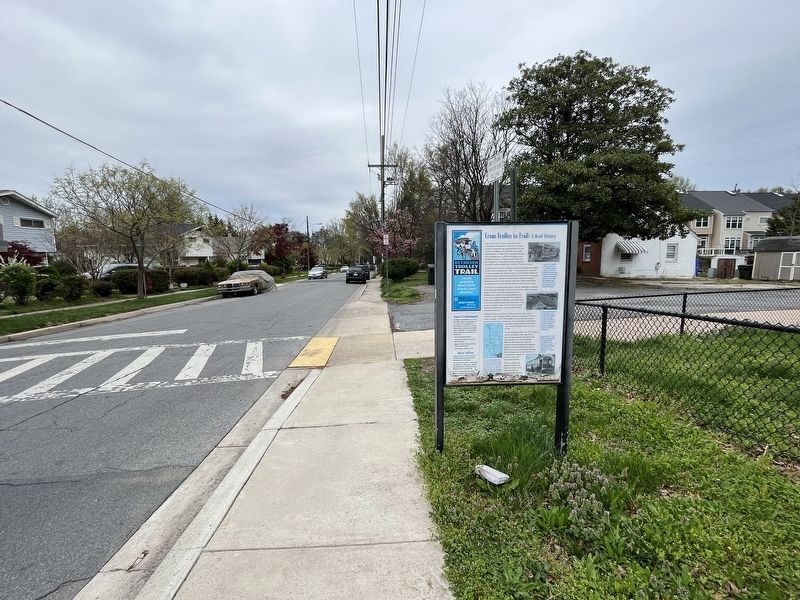Rockville in Montgomery County, Maryland — The American Northeast (Mid-Atlantic)
From Trolley to Trail: A Brief History
After the Civil War, America's cities created new transportation systems that enabled them to prosper and grow. During this time, major rail lines were built to connect Washington, D.C. with other cities. Smaller electric streetcar or 'trolley' lines connected Washington with its outlying areas. In 1890, the Georgetown and Tenallyetown Railway Company operated trolley lines from Georgetown to Montgomery County, using High Street and Tennallytown Road. (later to become Wisconsin Avenue).
At about the same time, the Tenallytown and Rockville Railroad extended the line north to Bethesda (Alta Vista). At the end of the line they built a Victorian era 'Trolley park,' Bethesda Park, as an incentive for evening and weekend usage. By summer 1893, it was one of DC's most popular amusement parks, complete with roller coasters, daredevil aeronautic performances, a dance hall, an hotel. In the fall of 1896, Bethesda Park was destroyed by a hurricane and the park was closed, never to re-open.
In 1897, the two railroads merged and by 1900 they completed an extension to the county seat of Rockville. At the turn of the century, trolleys transported people to DC for work and carried throngs of city dwellers to the county for the annual agricultural fair in Rockville. Trolleys moved goods from Georgetown shops to those living in farming communities along the line and took local produce from these country farms to DC markets. Trolleys made it possible for local students to attend the new suburban schools, as well as secondary schools in DC.
Washington Railway and Electric Company acquired these merged railroads in 1902. Washington Railway eventually became part of the Capital Transit Company. In 1935, the Rockville line ceased operation, leaving gasoline-powered buses to become the only mode of public transportation serving this corridor until the Metrorail Red Line extension to Shady Grove was opened in 1984.
The new Bethesda Trolley Trail (BTT) utilizes much of the original trolley right-of-way. Since the opportunity for this rail-trail was first identified in the 1978 Countywide Bikeways Master Plan, the County has required new land developments to dedicate land and construct portions of the trail. In 2004, the County Council authorized funding for the Montgomery Department of Transportation to design and construct many of the missing segments.
Wherever possible, the Bethesda Trolley Trail utilizes low-impact urban design principles of environmentally 'green design.'
[Captions:]
This map shows the original trolley routes that connected city and county. The Rockville line started as a double track to the District line, switching to
![From Trolley to Trail: A Brief History Marker [Reverse]. Click for full size. From Trolley to Trail: A Brief History Marker [Reverse] image. Click for full size.](Photos7/715/Photo715806.jpg?472023125700PM)
By Devry Becker Jones (CC0), April 7, 2023
2. From Trolley to Trail: A Brief History Marker [Reverse]
In the 1890's, Tenallytown* trolley cars, such as this one, made their way from Georgetown to the District boundary at Western Avenue using overhead electric power. An elaborate underground electric system was required for all downtown trolley systems; however, at that time, Georgetown was not considered 'downtown.'
In this photograph dated 1910, a trolley heads south from Rockville toward Tenallytown through open farmland. This view, south of Montrose Road where it intersects with Rockville Pike, shows the Villa Roma restaurant in the foreground and the Pike in the background.
Passengers board car # 596 heading to Rockville in 1908. These distinctively styled cars, particularly known as 'Rockville' cars, were used on Washington Railway's Maryland line. Note the 'people catcher' or 'lifeguard' on the front.
Erected by Montgomery County Department of Transportation.
Topics. This historical marker is listed in this topic list: Railroads & Streetcars. A significant historical year for this entry is 1890.
Location. 39° 3.819′ N, 77° 7.241′ W. Marker is in Rockville
Other nearby markers. At least 8 other markers are within 2 miles of this marker, measured as the crow flies. Historic Montrose School (approx. ¾ mile away); Montrose School (approx. ¾ mile away); a different marker also named From Trolley to Trail: A Brief History (approx. 0.8 miles away); Veirs Mill (approx. 0.8 miles away); a different marker also named From Trolley to Trail: A Brief History (approx. one mile away); John C. Brown Memorial Bridge (approx. 1.1 miles away); Autre - St. Mary’s Plantation (approx. 1.2 miles away); Maryland: Confederate or Union State? (approx. 1.2 miles away). Touch for a list and map of all markers in Rockville.
Credits. This page was last revised on April 7, 2023. It was originally submitted on April 7, 2023, by Devry Becker Jones of Washington, District of Columbia. This page has been viewed 85 times since then and 19 times this year. Photos: 1, 2, 3. submitted on April 7, 2023, by Devry Becker Jones of Washington, District of Columbia.

